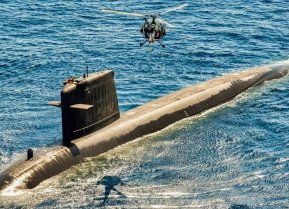Turkey Looks to Become the Next Aircraft Carrier Powerhouse
China and India now each operate domestically-produced aircraft carriers – but another nation is seeking to become a carrier powerhouse, namely Turkey.
China and India now each operate domestically-produced aircraft carriers – but another nation is seeking to become a carrier powerhouse, namely Turkey. Unlike many other carriers in service, the Turkish Navy's flattop was designed to operate primarily with unmanned aerial vehicles (UAVs).
Set to be the Turkish Navy's new flagship, the multipurpose amphibious assault ship TCG Anadolu (Turkish for the Anatolia peninsula) also represents the "Century of Türkiye," President Recep Tayyip Erdo an said at a ceremony last April, adding, "The TCG Anadolu ... is the world's first warship in its field where UAVs can land and take off."
The TCG Anadolu is based on the Spanish Navy's flagship, the Juan Carlos I, a landing helicopter dock (LHD) type of amphibious assault ship. The vessel is 231 meters (758 feet) long, 32 meters wide, and has a displacement of 27,436 tons. She can reach a top speed of 21 knots and has a range of 9,000 nautical miles and an endurance of 50 days at sea. The warship can carry 1,400 personnel – a battalion of soldiers/marines, along with combat vehicles and support equipment.
Ankara ordered the TCG Anadolu in 2015, while she was laid down in February 2018 and launched in April 2019. The inauguration was originally scheduled for 2021 but was delayed due to the global Covid-19 pandemic.
Turkey: Going For Two Aircraft Carriers?
At a January 3, 2024, meeting of the Turkish Defense Industry Executive Committee, Erdo an gave the green light for a second carrier, while plans were approved for the construction of the M LGEM 9-10-11-12th ships (I-class frigates), offshore patrol vessels, new types of landing ships, new generation minehunters.
Ankara had previously announced plans to build a sister ship, the TCG Trakya later this decade.
The TCG Anadolu, the largest ship to see service in the Turkish navy, has also been seen as a "dual threat," to potential adversaries as it has the ability to carry ground equipment for amphibious assault as well as to serve as a platform to launch drones.
Though based on the Spanish warship, the Turkish flagship is equipped with weapon systems, including combat management, electronic warfare, infrared search and track, electro-optical search, laser warning, and torpedo defense systems, as well as radars, that were all developed locally. In total, 70% of all the parts used in the ship's construction were sourced from Turkish firms.
A Drone Aircraft Carrier
Turkey, which maintains NATO's second-largest army, shares a border with conflict-ridden Syria and Iraq, while it also has a long Mediterranean Sea and Black Sea coastline. Istanbul, its largest city and former capital, is also located on the vital Bosporus Strait.
"(The TCG Anadolu) has the capabilities to conduct military operations in every corner of the world," Erdo an said last year. "We will be able to transfer to crisis areas with this ship quickly. We see this vessel as a symbol that will consolidate Turkey's regional leadership position."
Originally, Ankara had sought to acquire the Lockheed Martin F-35B, the short-vertical takeoff and landing (SVTOL) variant of the Joint Strike Fighter, to operate from the flattop. However, Turkey was expelled from the program after it went forward with the purchase of the Russian-made S-400 air defense system, which U.S. and NATO leaders argued would compromise the security and capabilities of the fifth-generation stealth aircraft.
While still under construction, Turkey converted the TCG Anadolu into a drone carrier. It will still be able to operate with helicopters, but Ankara has announced it will be used to deploy the domestically-built Bayraktar TB3 and Kizilelma drones. The Kizilelma has been described as a "fighter UAV" that possesses stealth as well as aggressive maneuvering capabilities.
"The TCG Anadolu is a game-changer for Turkish naval power and power projection capabilities," retired U.S. colonel Rich Outzen, a nonresident senior fellow at the Washington-based Atlantic Council, previously told Middle East Eye. "The first 'drone carrier' will enable Turkish forces to conduct reconnaissance and strike operations against naval and littoral targets across the Mediterranean."
The Turkish people were not originally what could be described as a "sea-going people," but in the Ottoman-era, the Turks successfully became a major sea power in the Mediterranean Sea. Now a century after the dissolution of the Ottoman Empire, the modern Turkish Republic could be looking to flex its muscles in the regional waters and far beyond.
Author Experience and Expertise
Peter Suciu is a Michigan-based writer. He has contributed to more than four dozen magazines, newspapers, and websites with over 3,200 published pieces over a twenty-year career in journalism. He regularly writes about military hardware, firearms history, cybersecurity, politics, and international affairs. Peter is also a Contributing Writer for Forbes and Clearance Jobs. You can follow him on Twitter: @PeterSuciu.
Image Credit: Shutterstock.


